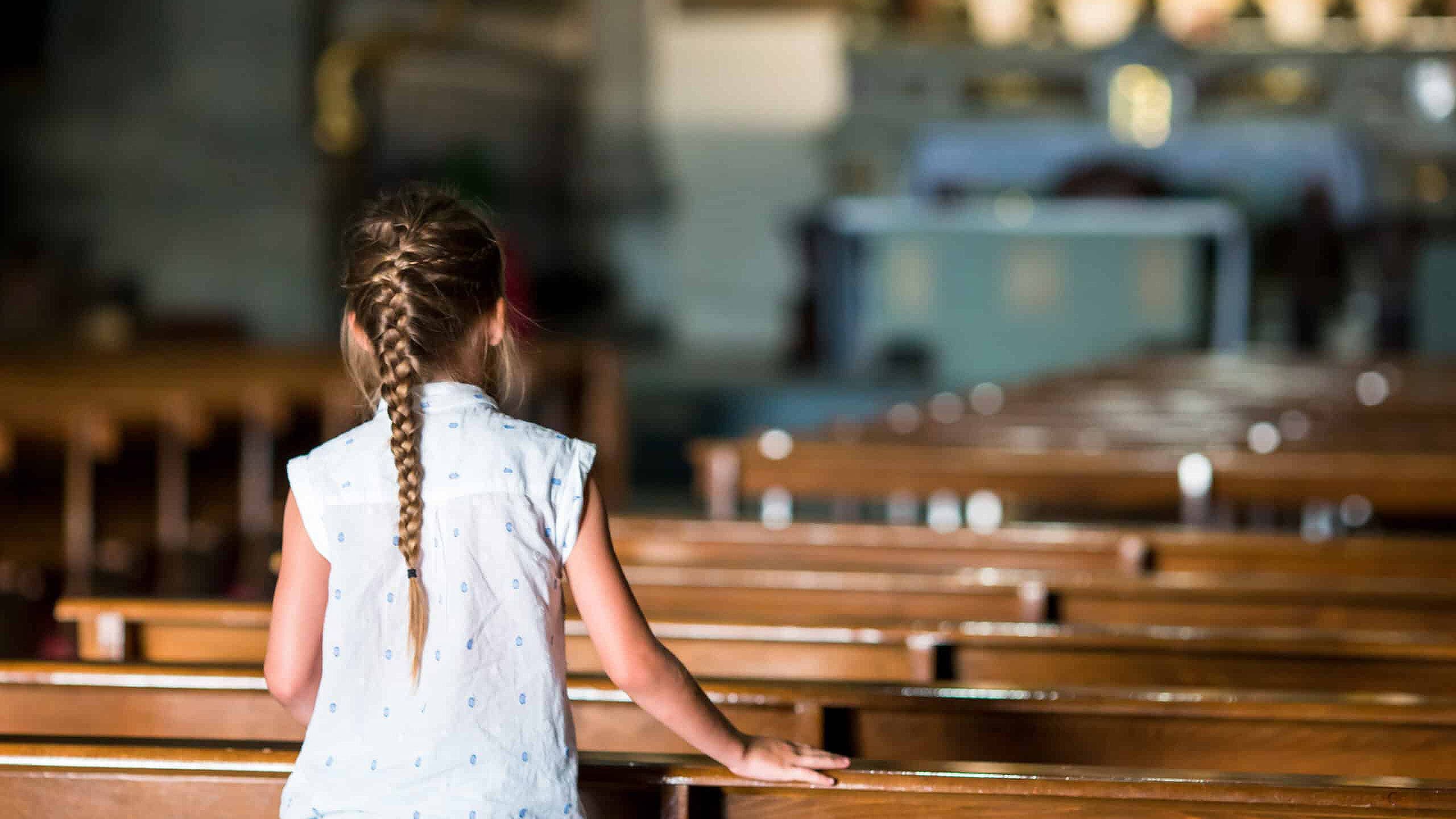W
When I walked into our congregation’s Ash Wednesday service last month, my first thought was, “Oh, no.”
In the middle of the room, where the small candles and kneeling rugs usually rest during Lent, were two large, shallow boxes—almost like raised planters—filled with dirt. Our pastor’s words at the beginning of worship didn’t do much to dispel my concern: she invited us to come forward throughout the service as we felt led, feel the dirt, play with it even, plant acorns, and connect with the experience of being from the dust ourselves. And sure enough, as the music started up and a friend’s small son sprinted forward with a look of delight on his face, it played out exactly as I expected. Throughout the service, adults came forward to have a moment with the dirt, but it was mostly children with their hands in the boxes, playing with the sod, sculpting it, digging in it, and scampering back and forth while the grownups were busy remembering that we are all going to die.
There is something so beautiful, so rare, and so distinctive about a room full of adults making promises to an uncomprehending infant and bearing witness together to the covenant God has made with us all.
After the service, gazing over at the mounded and disheveled dirt, our pastor observed to me, “I didn’t take the sandbox effect into account.” Then she paused. “I think that was exactly what we needed.”
She was right.
We don’t encounter very many spaces that attempt to bring children and adults together in a common endeavour, a shared life. For the forty-five short minutes of our Ash Wednesday service, those children were allowed to respond to an invitation in their own way and to be present in a worship space as children—not simply adults in training. And those of us who watched, with some unease, as they bulldozed the dirt and blissfully ignored the sermon, needed them to be there.
There is a deep ambivalence toward children in twenty-first-century American life. In The Children and the Theologians, Jerome Berryman uses “ambivalence” to describe “the church’s delight and aversion, attraction and repulsion, and emotional closeness to and distance from children.” Those conflicting attitudes are well at play outside of church walls: our San Francisco city buses are plastered with fertility center ads announcing “We Deliver Joy!”—and the parenting shelves at my favourite bookstore are stocked with the bestsellers All Joy and No Fun and Go the F*** to Sleep. Children delight us, drive us up the wall, invite kindness, and trigger our deepest anxieties, often within minutes. We will spend enormous amounts of money to conceive them—the fertility industry is worth billions of dollars, and growing—but once born, we shunt them out of adult spaces into age-segregated day cares, classrooms, and camps until they’re eighteen. Ambivalence, indeed.
Our church—like many, I suspect—shares this conflicting stew of responses to children. We prize them, we pray for the adults who want so desperately to have them, we hold them up as longed-for blessings, and collectively beam indulgently at the altar when they sing “Mary Had a Baby” in the Lessons and Carols service. We also send them away to their own worship spaces every week, fail to invite them back for the Lord’s Supper, shift uncomfortably when one of them makes what feels like an inappropriate amount of noise, and largely delegate their discipleship to “brave” volunteers and children’s ministry professionals. While they are in the sanctuary, the children are in our adult space, and there is almost a palpable sigh some weeks when all one hundred-plus of them troop out and off to children’s worship.
This is all perfectly normal and understandable. Children are delightful, and they’re terribly inconvenient: needy, noisy, not always cooperative with the rhythms of adult life. We want them in sufficient numbers to feel that a church is growing, but we don’t particularly enjoy sharing worship space with these small, restless bodies—at least, not during the “quiet” or “serious” parts of a service. Many parents genuinely need a peaceful hour on Sunday morning to reconnect with their own spiritual needs. But because we are ambivalent, at best, about the role children play in the life of our churches, many Christians simultaneously over- and undervalue children: childless adults feel like second-class citizens in churches organized around “family” programming, while children are banished to the basement to be educated rather than welcomed as fellow members of the household of God.
Normal and understandable, yes, but not right. Not if we believe what we say in that most ordinary, most amazing liturgical moment in our life together: baptism.
We baptize children four or five times a year at our church, and every time we do, I tear up. I’m not much of a public weeper, but there is something so beautiful, so rare, and so distinctive about a room full of adults making promises to an uncomprehending infant and bearing witness together to the covenant God has made with us all. Baptism—the reality it enacts, the community it creates, the future it promises—is such a radical proposition that I wonder, every time, if we can ever live up to what we’re offering these little ones.
The answer, of course, is that the promises of baptism are secured only by God’s grace. But as churches, we are responsible for creating lives together that bear witness to what we confess. And I wonder: Do we really live as though we believe these children are our brothers and sisters in Christ?
Most children I know, baptized or not, would look around at the adults getting their coffee and doughnuts on a Sunday morning and answer no. As best as I can tell—having spent years among them in children’s ministry—these children don’t experience church as a fundamentally different sort of space than any of the other age-segregated, adult-oriented places they spend their time. Programs, worship, and education are all organized to form adult disciples, and to train children as adult-disciples-to-be. Adults are authorities to be listened to and learned from rather than fellow pilgrims. The notion of a common life with adults who are not their parents, of the grownups around them as their brothers and sisters in faith, is as foreign to many of our church’s children as the hypostases of the Nicene Creed.
I’ll confess: this distresses me. The baptismal liturgy, when we actually attend to what we’re doing, is astounding, especially in a world that values above all else competence, achievement, adulthood. We gather and collectively make binding commitments, welcome a child as a full member into the visible body of Christ, and address someone who is often still in diapers not as “son” or “daughter,” but as “brother” or “sister.” Each time we sprinkle a little one with some water and hear the words, “This is a child of the covenant,” we are confessing a profound spiritual equality with these inarticulate, helpless little beings.
Can that possibly be true? Are the investment banker sitting behind me, the software CEO a few seats over, the recovering alcoholic, the nonprofit lawyer, and my own twelve-year-old daughter existentially, before God, no different from the toddler our pastor is holding up to bless? Do each of them need this toddler in their lives as much as this little one needs her protective, caring adults? Well, yes, says baptism. I may know more Scripture and why it matters whether the Holy Spirit proceeds from just the Father, or from the Father and the Son, but those things don’t save. What saves me, the investment banker, the toddler, and the entire universe is the death and resurrection of Jesus Christ, into which I have been adopted when I passed through the waters of baptism. There’s no other way home.
Our congregation is part of the Reformed Church in America, and our baptismal liturgy includes these lovely words: “For you Jesus came into the world; for you he died and conquered death; all this he did for you, little one, though you know nothing of it as yet.” While those words are spoken to the child being cradled next to the font, they are for all of us as well. Isn’t that the story for everyone in Christ’s church? We have been sought, welcomed, delivered just as surely as this small one by a grace and power that are not our own. Our privilege as adults in this moment is to bear witness to the truth about ourselves and our loving God that we may have discovered with time, but that has been and will remain true regardless of our ability to cognitively process it.
The Hebrew Scriptures as well as Paul’s letters are full of the language of adoption, of people being chosen before they have any understanding of what is going on. When a child is adopted, she is welcomed into a new family, given a new name and immersed in a stream of history, lore, tradition that gradually becomes her own as she grows. When we welcome children into the “visible membership of the holy catholic Church” at their baptism, we are affirming their identity as inseparable and necessary members of Christ’s body just as thoroughly as siblings welcoming a newly adopted baby into their home. We all entered this family in the same way, and though we may have different ages, sizes, abilities, or understanding, we are all brothers and sisters in this household.
If all of this is true, then churches need to examine and address their underlying ambivalence toward children. It’s an ambivalence rooted in perfectly normal distinctions between what is grown up and what is childish; between what we acknowledge as capable and competent and what is helpless and unformed; between educated and ignorant; between who is valuable and has something to offer and who is negligible and worthy only to receive. And it’s an ambivalence that is radically undercut by the profound equality we share as adopted members into a family we didn’t create and certainly didn’t earn our way into.
It’s an ambivalence that is radically undercut by the profound equality we share as adopted members into a family we didn’t create and certainly didn’t earn our way into.
In Offering the Gospel to Children, Gretchen Wolff Pritchard writes,
Baptized children are not recruits or trainees. They are Christians. It is their birthright as Christians to be included in the life of God’s people in community: to approach God in awe and love in worship, to be welcomed into the sacred space, to receive Christ’s Body and Blood, to know and be known to their fellow-parishioners by name, and to express their faith in service, not as a class exercise only, but as members of the parish family.
How can we do that? How can we move beyond ambivalence and discomfort and into a full welcome of children as fellow pilgrims on the journey of faith?
To start with, we need to heed Pritchard’s advice from the same chapter of her book: bring children out of the basement (or wherever the children’s ministry is siloed away) and start treating them like fellow Christians. Yes, children’s ministry has an important role. But all too often, it operates on the margins of a church’s life. The children have their own curriculum, independent of what the adults are doing upstairs. One or two people on staff—or just a few worthy volunteers—own the program, and everyone else can turn away to get on with the real business of ministry and service. If you’re wondering how fully your church’s children are integrated into the larger congregational life, ask yourself: How often are the head pastor or other non-children’s-ministry staff in the children’s worship space? How often am I? And what percentage of your congregation knows the names and ages of at least five children outside of their own family? If the answers are “rarely,” and “below 50 percent,” you can be sure that the lives of these young Christians are not visible, integral, or fully valued as the vital gift they are to your church.
Children’s spiritual lives are real, and they are valid right now—not simply as embryonic forms of what will hopefully mature into adult faith, but as fully human engagements with the Lord who loves them exactly as they are. In 1 Corinthians 12, Paul admonishes us, “The eye cannot say to the hand, ‘I have no need of you,’ nor again the head to the feet, ‘I have no need of you.’ On the contrary, the members of the body that seem to be weaker are indispensable, and those members of the body that we think less honorable we clothe with greater honor, and our less respectable members are treated with greater respect” (vv. 21–23 NRSV). Children may be weak, and they may not be very respectable, but they are indispensable members of the body of Christ who are worthy of honor, deep knowledge, and inclusion as they are, at this very moment.
What does that mean, in practice? Don’t we have a responsibility to educate children in the faith? Well, yes. But when we baptized these children, we promised together “to love, encourage and support these brothers and sisters by teaching the gospel of God’s love, by being an example of Christian faith and character, and by giving the strong support of God’s family in fellowship, prayer, and service.” We are called to be with children in worship and discipleship, to hold our faith in common rather than simply pass it on. In Calvin’s words, “Infants are baptized into future repentance and faith, and even though these have not yet been formed in them, the seed of both lies hidden within them by the secret working of the Spirit.” Christian faith is not something we possess and can hand off; it is a reality that has been planted, watered, and cultivated by the divine Spirit of love. Our adult seeds may be a little more fully blossomed, and we may have more practice at pruning and encouraging growth, but that just means we need to invite children to learn to garden alongside us.
There are myriad ways to bring children and adults together into a genuinely intergenerational worship community, and any church with a modicum of creativity, flexibility, and grace can try. The most important starting point is to actually have children in our midst while we worship, and most especially around the Lord’s Table. All of the elements of life in Christ are there: confession, unconditional forgiveness, welcome, renewal, and communion with the Lord and one another. A shared Eucharist is the soil from which genuinely Spirit-filled communal life grows; it is also instruction and discipleship in one, not just for discursive adult minds but for our bodies and hearts regardless of what we understand. Children who regularly feast at the Lord’s Table can then hear the Scriptures, learn the stories of the faith, and begin to piece together doctrinal knowledge in the assurance that all of this is for them, because they have already tasted and seen that God is good.
And those of us who are adults—whether we are parents or not—need children at the table, in our sanctuaries, sharing our lives. Jesus told us we do. He is at work in them as surely and effectively as in any seemingly successful, capable adult we meet. We need to hear, in their own words, how they have encountered God today. We need their prayers, their encouragement, their fellowship, not because children have something unique to teach us but simply because they are intrinsically, irreplaceably valuable to the Lord. God has chosen and adopted all of us, not out of any virtue of our own, but out of sheer divine delight. We are children of God. These are our brothers and sisters, fellow sojourners on the Way, and we need them our midst.






